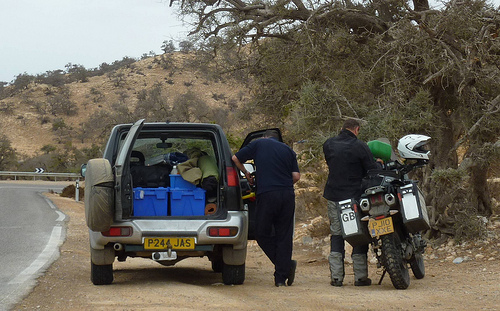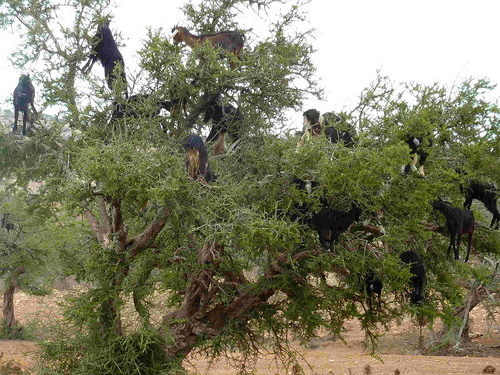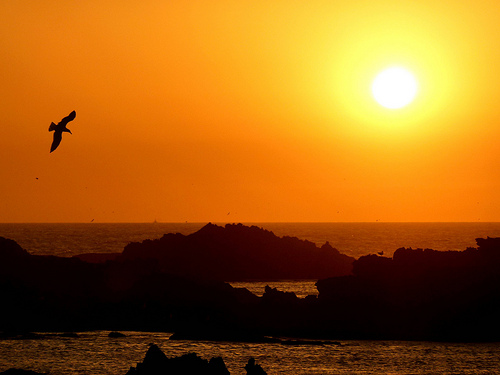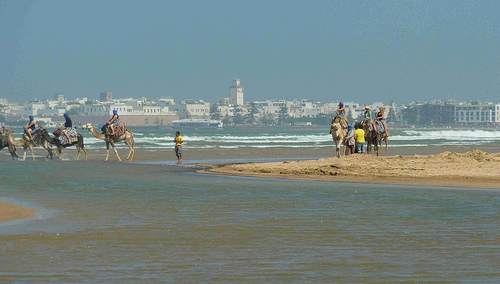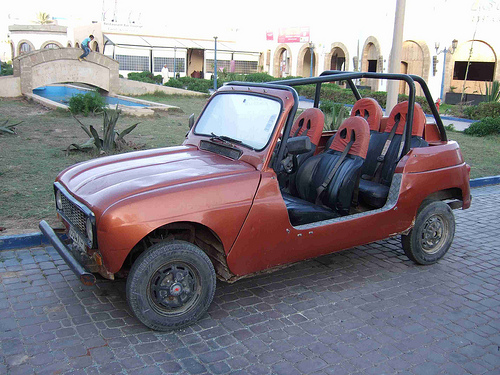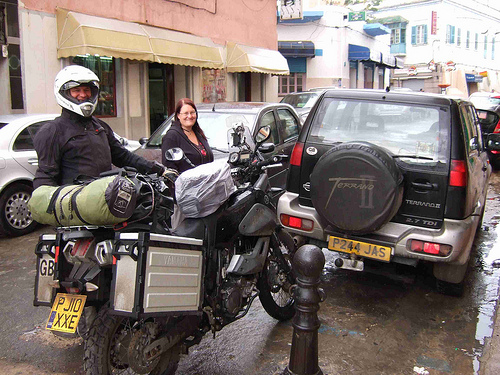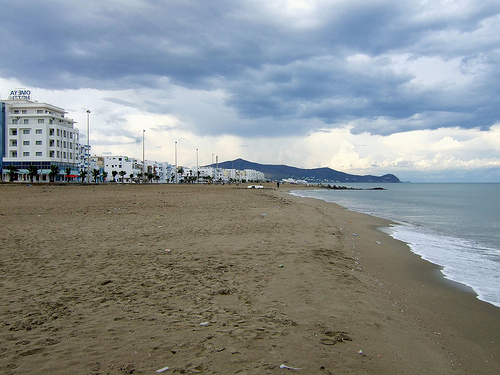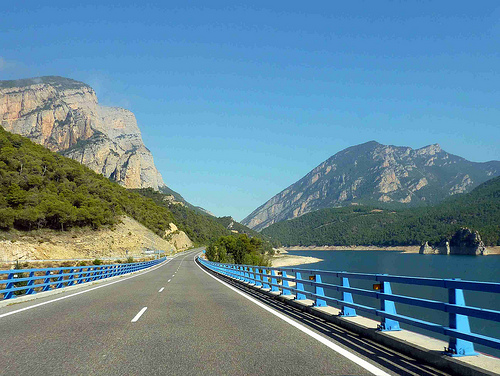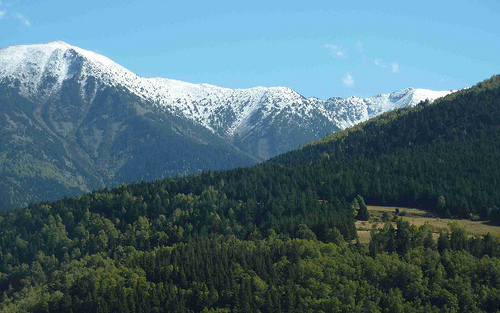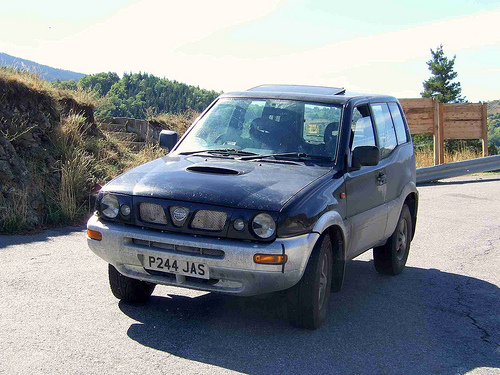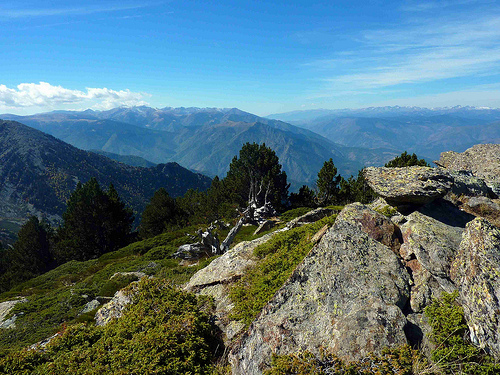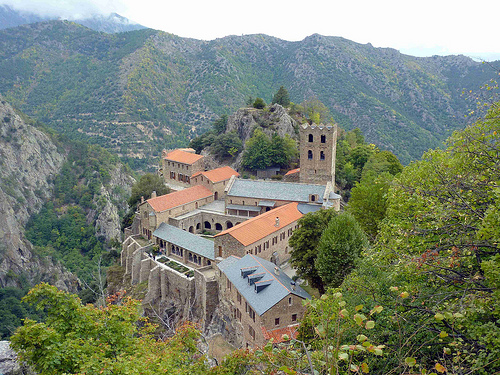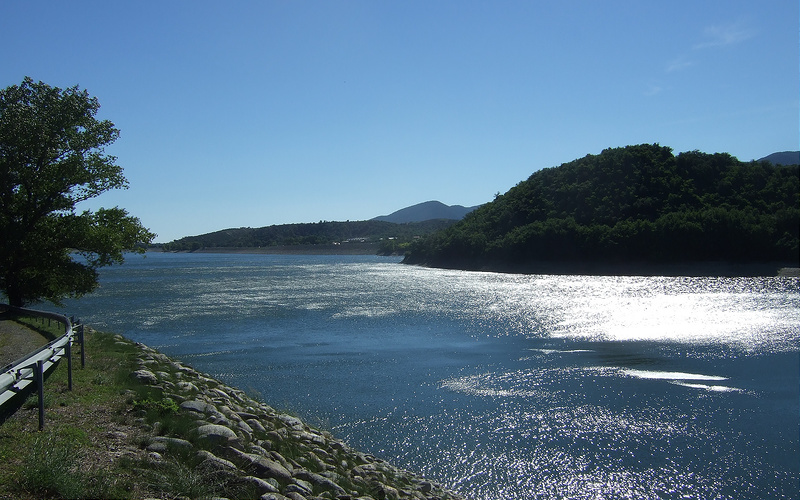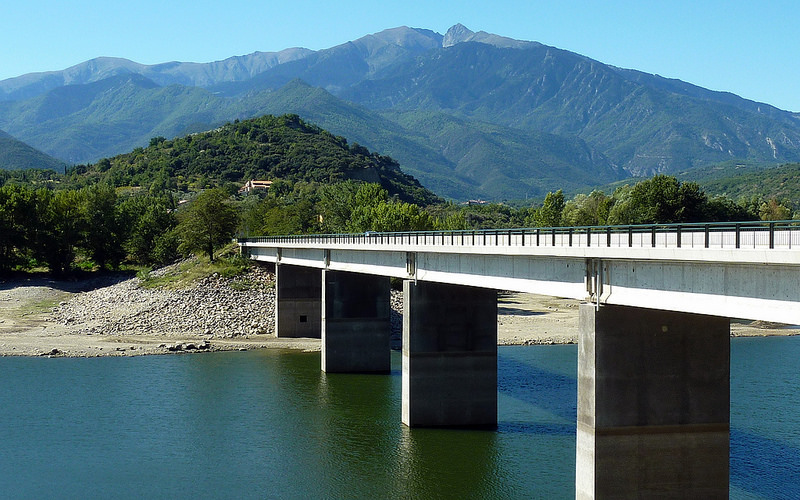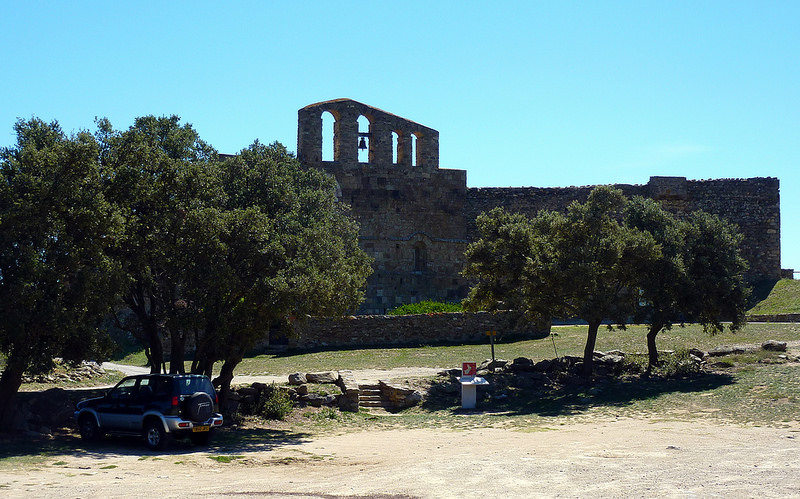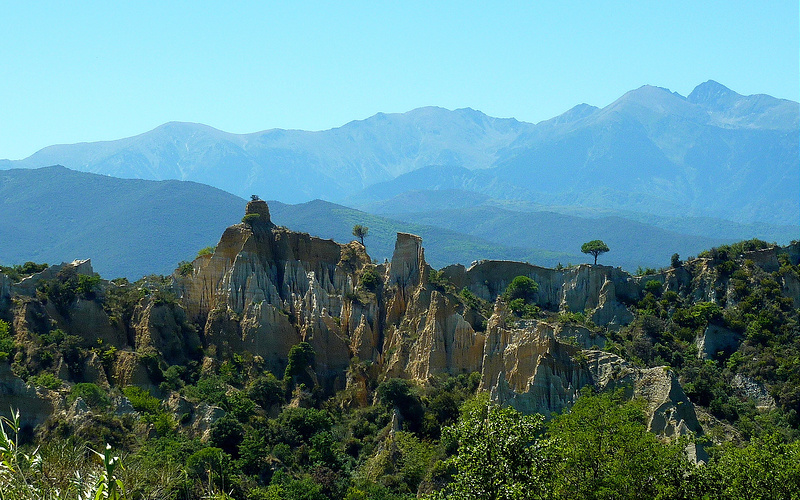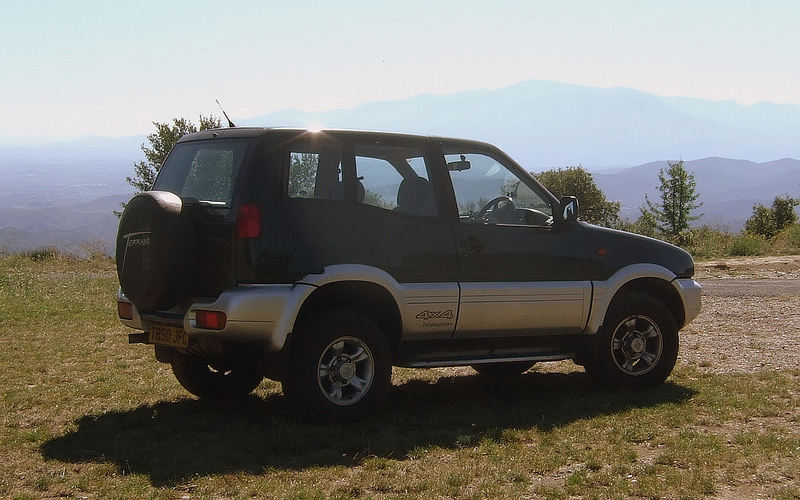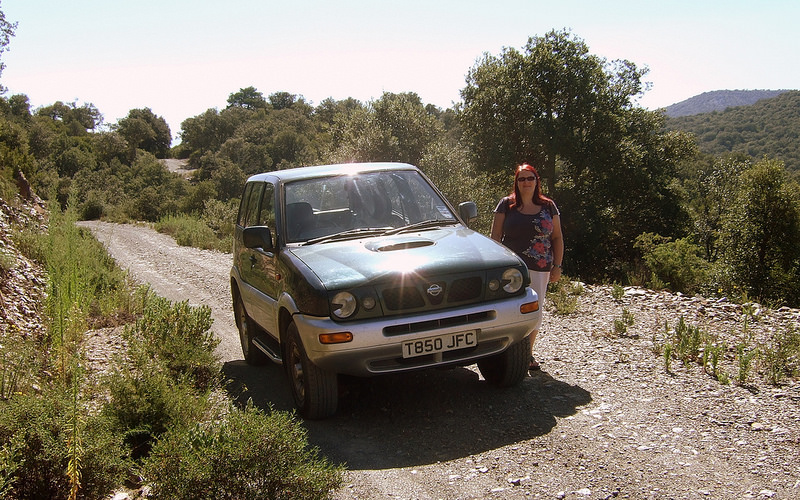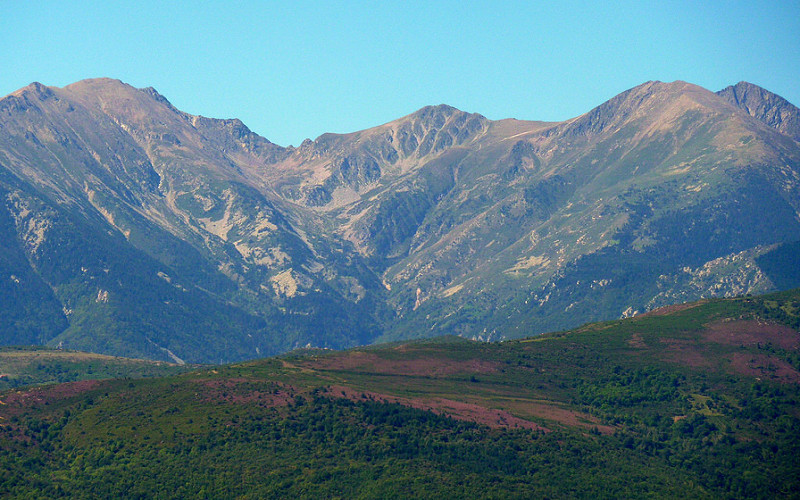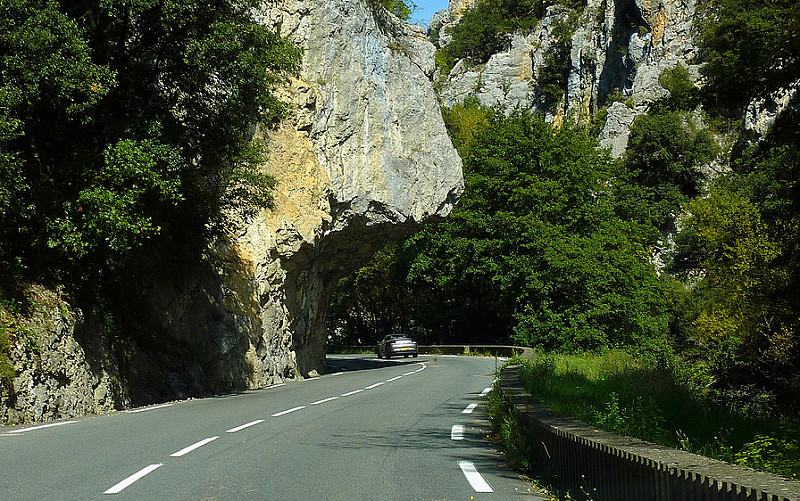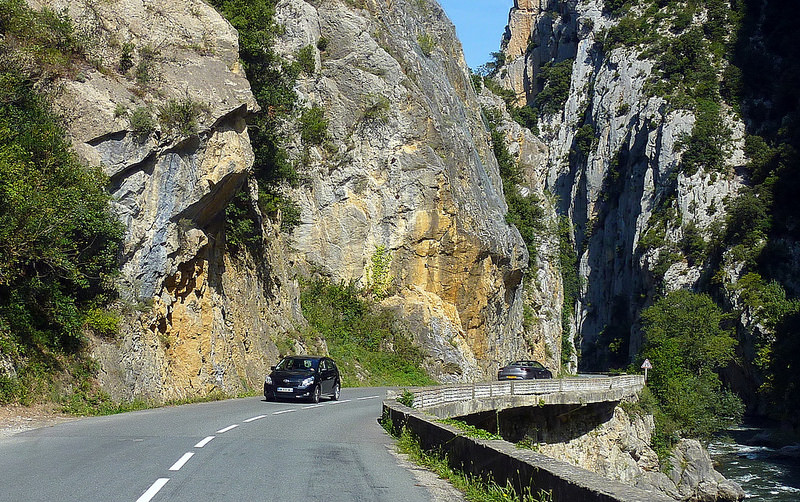Our guide is waiting for us as we emerge from the hotel. It is about half-an-hour before the agreed meeting time and we get the sense that they are very keen not to miss us. We need to go for breakfast and when we get back Ahmed introduces us to our official guide for the morning. His name is Abdul and we get shown his badge too. Clearly, Ahmed is more of a fixer than an actual guide and he farms the work out to his people and takes a percentage. Abdul tells us we will take a couple of ‘Petit Taxis’ to the medina and he has arranged a special rate of 10Dh for each vehicles. This seems quite reasonable and the journey isn’t too scary. The ‘Petit Taxis’ are mostly Red Fiat Unos carrying the battle scars of numerous contretemps with other road-users, and watching them in action is a good way to while away an idle half-hour. We drive past the Royal Palace (even though we have said we didn’t want to go that way) and drive the wrong way through the medina gate to avoid a large coach that has underestimated his width. The oncoming traffic doesn’t seem in the slightest bit fazed.
Abdul starts his tour outside the tanneries. He tells us we can have a two hour tour, after which he can take us to a restaurant where we can buy him lunch and he will fix us up with beer or wine. I don’t recall this being part of the deal. He goes on to tell us he normally takes German tourists around Fes, and apologises for his poor English. Actually, his English is fine and I expect he is fishing for compliments.
The tanneries are a must-see part of any visit to Fes. Louise and I have done this once, but we don’t mind another look and we know what to expect. Every leather shop surrounding the tanneries has a viewing platform, replete with free mint sprigs to provide a more pleasant small than the sharp stench of the ammonia. The animal hides are left in vats containing urine to strip the outer surface of wool or hair and soften the skins. From there, they are moved to the dyeing vats. The process is essentially unchanged from medieval times and the workers, free from H&S regulations, work bare-legged and thigh-deep in the vats. Strangely enough, their life-expectancy is a bit on the low side compared to the rest of the Moroccan population.
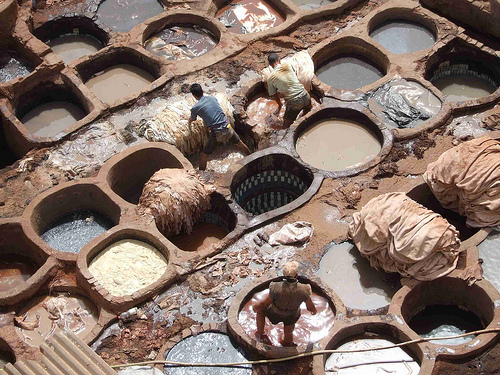
Fes Tanneries
Photos taken, our man Abdul takes us downstairs. You don’t leave the premises without trailing through each of three levels of leather goods of every conceivable type and colour. You are told Moroccan leather is the best in the world and urged to feel how soft it is. You can’t deny the leather is soft and the colours are vibrant, but the prices are not cheap. Simon sees a wallet he might actually like, but doesn’t like the starting price and simply doesn’t want to haggle. This refusal to take part in the ritual causes the shop-owner to lose interest and we migrate downstairs as a big group of tourists arrive from the viewing platform. On the next level, belts, bags, hats and Moroccan slippers are all politely declined. We are finally re-united with Abdul, who takes us to a carpet shop.
A shopping trip is what we didn’t want. We know what happens next. There is a quick spiel about the skill of the carpet weavers and the how long it takes to make a carpet and then a multitude of carpets in a bewildering flurry of colours and patterns are whisked out by the salesman, until the floor is covered. This shop is different, he tells us. Here, there is no need to haggle. The price is set by the government according to the type of weave and you know you won’t be paying too much. Within a couple of minutes, this fixed price has taken a 20% reduction because apparently this is the tourist low season. Needless to say, we have assured our host that we’ve seen many Moroccan carpets before and we really don’t want one. This doesn’t seem to affect the speed with which new samples are displayed. By now, there are two assistants who are rolling up the old carpets and replacing them with new ones. Finally, we have to say quite clearly we don’t want to buy a carpet, making sure to thank our host profusely for his time and effort.
Abdul takes us to see the narrowest street in Fes, which is about two feet wide at its narrowest. The walls of the buildings either side are at least three storeys high, so it is not a great space for those afflicted with claustrophobia. Just as we think we are getting more tour and less shopping, Abdul takes us into a spice shop. Here, the salesman tries to flog us argan oil, black anise, ginseng (aka Moroccan Viagra), mild curry, hot curry, 49-spice mix and novelties like magic lipstick. We finally cave in and buy some curry powder at a vastly inflated price, thinking this will get us out of the shop a bit quicker. In spite of this, he persists in trying to flog us more stuff up to the point we walk out of the door.
We walk towards one of the main streets through the medina and Abdul tells us the tour is finished. It is on the dot of eleven and he asks whether we still want to stay here or come with him to get a taxi back to the hotel. He is a little surprised when we say we want to stay but he shows us where we are on the ‘Lonely Planet’ map and with more than a dash of irony, he wishes us good luck. He clearly doesn’t rate our chances.
We navigate our way back to the tanneries because we want another look from a better position over the dyeing vats. Dodging all the would-be guides we nip up a staircase on the end of a big group and find an ideal viewing-point. We take some more snaps and descend the stairs, but instead of visiting the shops on each level we cause great consternation by going straight down to street level and out into the crowd.
Our DIY tour takes us across the whole medina and we get to see many more souks than on the official tour. The downside is that we are slightly lost and have to resort to asking for directions from a shopkeeper. Eventually we emerge into sunlight and we have found the right gate. We pick up a ‘Petit Taxi’ and get back to our hotel rather more quickly than it took us to get to the medina. Abdul’s special rate of 10Dh per taxi is halved on the return journey, and we are rather pleased to have avoided his original threat to join us for lunch.
We are getting a little tired of the ever-present hustling, so it is a pleasant change when we go out for dinner to a hassle-free restaurant called ‘Mona Lisa’ and get served three huge pizzas that are so big none of us can manage more than half. We all have to take the uneaten portion back to the hotel – it will suffice for lunch on the road tomorrow.
Back in the room, I deploy our secret weapon. We have brought a 5 litre wine-box from France and as we are all getting tired of sugary soft drinks, it makes for a pleasant nightcap.
Day 43 – Wednesday 19th September: I have not been looking forward to exiting Fes. Congestion is something I can cope with, but the traffic here is as mad as a box of frogs and twice as unpredictable. I needn’t have worried. After paying off our ‘Parking Guardian’, we make light work of navigating to the right road for Ifrane. The traffic is light and Simon has donated his off-road satnav which is loaded with a 1:50,000 map of Morocco. It isn’t perfect by any stretch of the imagination, but it is a big improvement on the paper map.
We head south and pass through some very scenic countryside. The farmland gives way to apple orchards as we climb towards the Atlas Mountains. With altitude, the temperature is cooler and as we reach Ifrane, the grass is very green and the houses have very steeply-pitched roofs. The French developed the town as a ski resort, but its main function these days is as a summer retreat for the King and the well-to-do Moroccans. We drive past the King’s palace grounds, and the grass is exceptionally green and beautifully manicured.
From Ifrane, we climb higher still, into the cedar forest which is a nature reserve and is home to a huge population of Barbary apes, one of whom is guarding the road. We almost expect to be asked to pay a toll, but at the last moment, the ape gets up and wanders to the side of the road.
As this cooler temperature is a novel experience, we decide to call a halt and have an early lunch stop. The pizza boxes come out and so do the cameras.
Back on the road, we experience another abrupt change of scenery. At the crest of a rise, the forest disappears, to be replaced with a more barren landscape of pinky-red rock. Judging from the signs, this area gets badly snowbound in winter and barriers at various points suggest the road is routinely closed. Now, however, it is getting rather hot again.
We reach a town called Midelt, where we decide to have a drinks stop. We pull up at a café that already has a French family perched on the terrace and we join them. We are slow to realise that the café is run by the Moroccan equivalent of the Marx Brothers, who heap a thousand welcomes on us. We order drinks (no problem) and bread and salad arrive, but no drinks. We send the food away, but a few minutes later it re-appears. Still no drinks. Our drinks order gets taken again by another waiter, but he gets it wrong and we have to correct it. We wait for a bit longer, more food appears and is sent away, until finally I run out of patience and announce my intention to leave. At this point, and with a thousand more welcomes, the drinks arrive from the café across the street.
Apparently, the French family also arrived for drinks but were persuaded to have some lunch. We are all treated to the head comedian firing up the deep fat fryer on the pavement to complete their order with some frites. No matter that it appears to be a little late. The French family appear to be more than a little bit bemused, or perhaps it was just great entertainment for them. We ask for the bill and instead of a fixed price we have to barter the cost of our drinks down from 50Dhs to a more realistic 20Dhs. With another thousand welcomes ringing in our ears, we leave, wondering quite how the French family will settle their bill.
From Midelt, we head across what has now become stony desert or hammada and begin to climb up a series of impressive hairpin bends. This rocky upland is the starting point of the Gorges de Ziz. The river has carved a huge channel deep into the rock, and when the water level is higher, the blue-green of the river contrasts beautifully with the arid browns of the gorge. Today, the river reflects the grey of the overcast sky and it is a little disappointing. We stop long enough to take photos and journey on to another viewpoint. A little further down the road at the Barrage Hassan Adakhil, the water level is higher and we get some better pictures.
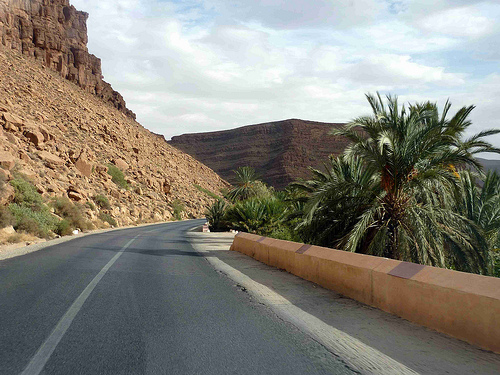
Entering the Ziz valley
Our overnight stop is scheduled at Er-Rachidia and we have chosen a hotel from the ‘Lonely Planet’. Unfortunately it is closed and has been for some time, and as we roll up and discover this, we are immediately approached by two locals who know a great hotel in town. We are slowly realising that most Moroccans possess an extremely sensitive tourist radar adept at converting any encounter into a potential to earn money.
In the absence of any other accommodation leads, we outline our requirements and after a quick phone call, presumably to arrange a mutually-agreed commission, they take us to a suitable hotel. However, from their point of view, that is not the end of the matter, and as we step out to get some dinner, they are wait to talk to us and organise the rest of our trip to Morocco. I explain with as much diplomacy as I can muster that we want to organise our own trip and while their help to find a hotel is much appreciated, that is as far as it goes. They accept this in reasonably good grace, but, like our guide in Fes, clearly seem to think we have made the wrong decision. However, I know where the hotel with a bar is located, and we make a beeline for it and enjoy a few bottles of ‘Flag’. At 25Dhs for a 25cl bottle, it’s not the cheapest beer I’ve had, but it was nicely chilled.
Day 44 – Thursday 20th September: We see no signs of our aspiring travel consultants and check the vehicles over before loading them up. Today we plan to travel the last part of our journey into the desert area. The edge of the Sahara reaches eastern Morocco across the Algerian border and is a popular tourist destination called Erg Chebbi. It boasts the classic sand dunes most people imagine the desert to be and the area has spawned a string of auberges along the edge of the dunes, together with a ready supply of camels, 4x4s and quad bikes.
From Er-Rachidia, the road south takes us through the rest of the Ziz valley. The sun is out today and the temperature is climbing. We reach the top end of a dramatic gorge filled with green palmeries and feel obliged to turn around and drive back to the summit to take photos and admire the scene from a Berber tent café.
The road follows the Ziz river, which in turn provides essential water for the string of villages along the route. Eventually, the valley walls give way to flat, featureless hammada fringed with distant jebels. Sitting in the middle of this desolation is Erfoud, which has a bit of a wild-west feel about it, complete with a multitude of horse-drawn carts and a ramshackle high street, which is only half-completed. Unfortunately, my half of the carriageway is part-asphalt, part-dirt and littered with numerous potholes and raised manhole covers. It is work-in-progress and a complete dog’s dinner. We drive at what I consider to be a safe speed which encourages some of the more enterprising locals to offer their services as guides.
Safely through Erfoud, we drive through more hammada and arrive in Rissani. In this town, the most popular mode of transport is the bicycle. Simon says it reminds him of Holland. The road-sense on display varies from poor to appalling and is coming from all sides. No-one here has any chance of passing their cycling proficiency test and I do not relish the idea of dealing with the consequences of a close encounter. I finally breathe a sigh of relief as we reach the palmeries that fringe the far side of the town and the kamakazi push-bikers thin out.
We are now on our last leg, heading south toward Merzouga and the in far distance, we see the rolling profile of the golden-pink dunes of the Sahara shimmering in the heat haze. We have been told the Auberge de Sud is a good place to stay and when we see a painted board pointing east across the hammada, we turn off the road and I engage 4WD for the first time since those Pyrenean mountain tracks.
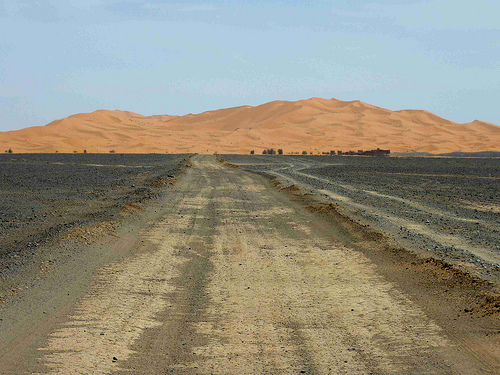
Off road to Erg Chebbi
I soon discover that the surface of a desert piste tends to develop a series of hard rib-like ripples which creates a bone-jarring ride. Apparently, these structures are caused by countless 4x4s, but I am unable to figure out how this might happen. The alternative to a chronic vibro-massage is to go off-piste, but this depends on the surface. There are some very large stones dotted about and hitting these at speed doesn’t bear thinking about. We pick and choose – the softest ride also raises the biggest dust-trail, and Simon is already dropping back to avoid asphyxiation.
As we reach the dunes, we have to head north and the sand makes for a much more comfortable ride. The Terrano squirms a bit but manages to feel quite sure-footed and this kind of driving is quite enjoyable. Simon’s experience is less happy. While he was riding the piste with ease, he is now struggling to keep a fully-laden bike upright.
We arrive at the Auberge de Sud. Its title must be derived from a general notion of ‘southness’ since its actual location is at the northern end of Erg Chebbi. It is just after midday and getting very hot. We have also developed quite a thirst and our bottled water is close to the right temperature for a nice cup of tea. We enter the reception and the contrast is remarkable – cool, dark and tastefully decorated with vaguely authentic artefacts.
Top tip to all considering a trip like this – if you intend to travel 40kms across the desert to an isolated place, contact them beforehand to check they have accommodation available. The guy on reception apologises – he has no rooms as there is a large party arriving in the evening which has wiped out all the accommodation. He offers us the alternative of a night in the berber tents he has at the back of the auberge. He invites us to stay for lunch while we make up our minds and this turns out to be a cunning ploy. The food is excellent, the water is chilled and there is a large swimming pool close by. The alternative is some more piste-bashing to another auberges and as the temperature continues to climb, this really doesn’t appeal.
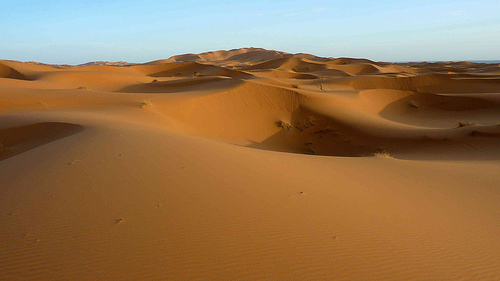
Erg Chebbi
We take full advantage of the pool and relax in the shade. In the early evening, we set off on foot into the dunes to climb to a vantage point to watch the sunset. We decline the camel-train. Bitter experience with these ‘ships of the desert’ are that they are uncomfortable and grumpy. Although it involves a bit more effort, you get a better feel for the desert on foot. Our timing is near-perfect and we reach the highest dune a few minutes before sunset and take the mandatory photos.
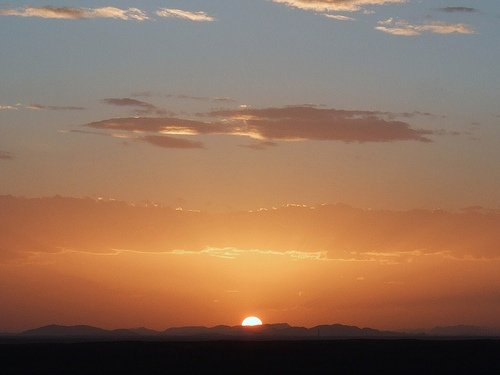
Erg Chebbi sunset
When we return to the auberge, we find a fleet of Toyota Landcruisers outside, signalling the arrival of the large party. The animated conversation from within suggests they are all Norwegian and the mood of the auberge has changed from a cozy little club to a full-on hotel. The staff are all rigged out in blue Tuareg jellabas and turbans and are doing their best to create an authentic desert experience. After a eat-all-you-can buffet dinner, they pull out the drums and try to put on some after-dinner entertainment. The Norwegians must be tired as they are not known as party-poopers. Virtually all of them bomb-burst away to their rooms for an early night. Perhaps the non-availability of alcohol has something to do with it.
We retreat to our desert camp, pull up three stools and three mugs and take solace in the wine box. Happily, both it and the ambient temperature has cooled sufficiently to be enjoyable. We turn in when the lights go out and for once the night is pleasantly cool. A good sleep was had by all.
Day 45 – Friday 21st September: Today we are driving to Zagora and a substantial part of the way is off-road. I am not looking forward to it and worry about the possibility of punctures and breakdowns. I console myself in the fact that I have covered most of the obvious contingencies.
Simon and I spend half an hour checking over our vehicles. All the fluids are in the right places and right quantities, but I find that my battery has started migrating – presumably the effect of bouncing around on the piste. I ratchet it down a little tighter.
We head off before 9am and use another piste to get to the road. As Simon can ride the ripples more easily, we wave him on and he is waiting for us at the road. The contrast once we start driving on tarmac is stunning. Even bad surfaces feel like a feather bed in comparison to the piste. After Rissani, we head foe Mecissi and pass through yet more breath-taking scenery and the largest herd of camels we have ever seen. They are spread far and wide across the hammada; about 150-200 animals all apparently under the care of a couple of herders who are following the road.
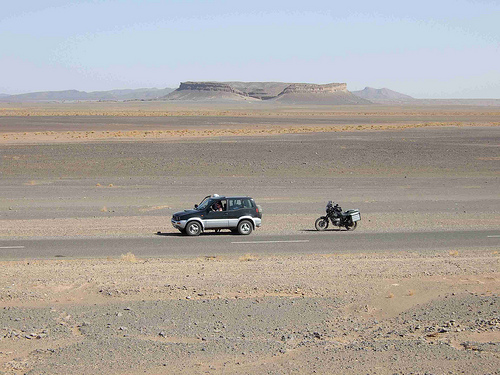
The road to Mecissi
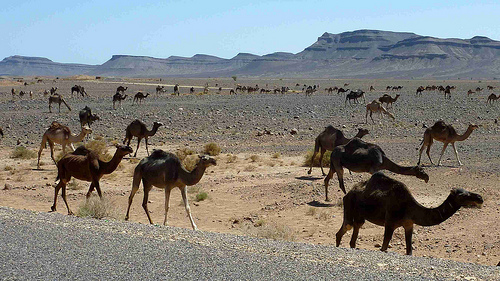
Hundreds of Camels
We are looking for a piste to Tissimoumane just before Mecissi which is marked on the map but fails to appear on the satnav. There are no obvious signs off the road and we stop at a petrol station to gas up and ask for advice. The attendant tells us it is about 12kms further up the road but that it is very difficult. This is not what I wanted to hear. On the map the route looks simple, and I have programmed in all the relevant GPS coordinates, so in principle the navigation should be straightforward. The absence of any piste is worrying. We decide to follow the main road towards Alnif, the next town, and if nothing obvious turns up, we will revert to our ‘easy’ option.
Nothing does show up. The satnav and the map disagree on everything and the chances are that any of the unmarked pistes we find will only take us as far as some tiny settlement. Local knowledge is everything and we have none, so we decide to head through Alnif, on to Taghbalte and then follow the marked piste to Zagora. It is about 60kms long and both the satnav and the map agree that it exists.
At Taghbalte, we stop in the shade of some buildings to have a final discussion about whether to proceed. This is a mistake, as our arrival is clearly the most exciting event this year. Hordes of children arrive to beg sweets and money, so we move further down the road. We have a little more time to talk, before the enthusiastic vanguard of another horde of children appear, running down the road. I have neither the time nor the inclination to win hearts and minds and fire up the Terrano before the little horrors arrive in sufficient numbers. We reach the outskirts of the town, and it becomes apparent that a major road-building project is underway to extend the road we are on all the way to Zagora. As we pick up the piste, it becomes clear that this has become the service road for the new road. The embankment has been built up, graded and compacted, but no road surface has been laid. The road has been barred at the beginning of the works but is a tempting alternative to the piste. We see a Moroccan in a Dacia Logan get on to the new road, so we follow him as far as another barrier of rubble, where we are forced to drive down the embankment to regain the piste. Our Moroccan friend tries once more to reach the new road and beaches his car on the lip of the embankment. Unperturbed, he gets his passenger to give him a shove and somehow gets it up. We have one more try and have to use low ratio to get up the embankment. Another 500 metres and we find another rubble barrier. Getting down from here involves physically moving some nasty-looking boulders out of our way before we can pick our way across the hammada to the piste. We decide that discretion is the better part of valour; the piste is slow and rough but it has less potential for disaster. Remarkably, the Dacia has survived and its driver has reached the piste in front of us. He is setting a cracking pace and is leaving a huge rooster tail of dust in his wake. I feel some sympathy for his suspension and wonder how he can maintain that speed without losing a mouthful of fillings. About 8kms further down the piste we pass him. He has pulled off to chat to a local who appears to be sheltering in a storm culvert under the new road.
We have now got my GPS showing the distance and heading to our waypoint at Tizi-n-Tafilalet and although we are referring to the map and the satnav, the compass pointer is somehow more comforting. The piste continues to follow the new road, although sometimes it veers away as we climb up a gentle slope up into the valley pass between two jebels. Just short of Tizi-n-Tafilalet we stop for some water and a chat. We appear to be in the middle of nowhere, but a small child appears, running in our direction from a single storey mud and straw house, cunningly camouflaged in a dip in the hammada. Amazingly, he doesn’t want sweets or money, he just wants to say hello, so we exchange courtesies.
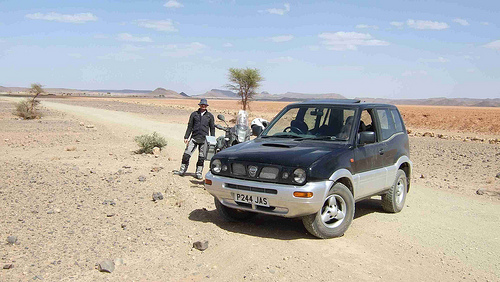
On the piste to Tizi-n-Tafilalet
After Tizi-n-Tafilalet, the wind gets stronger, blowing the sand and dust around and creating localised sandstorms. The piste gets a little more ragged and when we hit the dust storms, the visibility drops to a few metres – enough to pick out the piste, but not much more. When the wind drops, visibility improves, but it is a salutary lesson in desert travelling.
According to the GPS, we have another 30 kms to travel to Zagora and at the speed we have been doing since Taghbalte, that will take another two hours. We decide that Simon should push on ahead and out of my dust trail as he can stand up on his footpegs and travel faster across the bumpy piste. After a few more minutes, the piste meets the new road and a sign points to Zagora. Although there is no tarmac, the graded roadbed allows much higher speeds and we are doing 50mph in relative comfort. Within 15 minutes we are on tarmac and five minutes after that, we have reached Zagora.
It has been hot and thirsty work, so we pull up next to a shop to buy some drinks and immediately attract attention. We are already aware that Zagora has more than its fair share of hustlers, but nevertheless, it is still irritating. Our most persistent tout rides up on a scooter and is very keen to service my Terrano and Simon’s bike. He will change our air filters and our oil. He is about 18 and the state of his scooter is not a great advert for his maintenance skills. We both tell him ‘no’ in many different ways, but this does not discourage him and he tails us all the way to the other side of town before giving up.
We are following directions to a Riad called ‘Noble Savage’ a few kms out of town which we picked to avoid the hassle of Zagora. It is delightful but rather more expensive than our Time Out guidebook led us to believe. The cost is more than adequately compensated for by the warm welcome and discreet attention we receive from the owners and in stark contrast to the aggravation we have had today. Over welcome drinks and after-dinner coffee, we chat to the owners in a mixture of French and German. It appears that most of their customers are Germans but does not explain why they start a sentence in French and finish it in German.
Overfed, we retire to bed and I reflect on the day’s events. The Terrano has done well and seems largely intact after a very hard day’s drive. I am happy we chose the ‘easy’ option, but it was clearly anything but easy. The alternate route doesn’t even bear thinking about and I am happy to have dodged that particular bullet.
Day 46 – Saturday 22nd September: We have a very comprehensive ‘Noble Savage’ breakfast and our hosts spare no effort to ensure we are completely stuffed before we set off into the desert again. Both bike and car get a good mechanical and fluids check and it is clear that the dust has got everywhere; we can expect more of the same today. Today we plan to drive down to Tinfou to look at the dunes there, before heading off-road again to seek out a desert camp. We stop off in Zagora to buy two day’s worth of water and fuel. At the petrol station we again attract a local shopkeeper touting for business. I am quite brusque. I am buying diesel because I need it and I don’t need his scarves, wooden camels or fossils. He seems a tad offended but it has the desired effect.
We drive on through Tamegroute and the tarmac on the road to Tinfou literally shrinks to a single track. The only problem is that the road is quite busy and two-way so when vehicles travelling towards one another meet, they play a game of chicken to see who will blink first and veer off on to the hard shoulder. With a 4WD, this is quite easy and the suspension can cope quite well. The main dilemma is choosing where to get back on to the tarmac. My faithful tail-gunner is also having a game of his own. He sits a few metres behind my offside, and when I have to break right, he appears suddenly to the oncoming driver, who loses his nerve and has to take to the hard shoulder. This strikes me as a slightly dangerous but very laudable way to score the equaliser in our game of chicken.
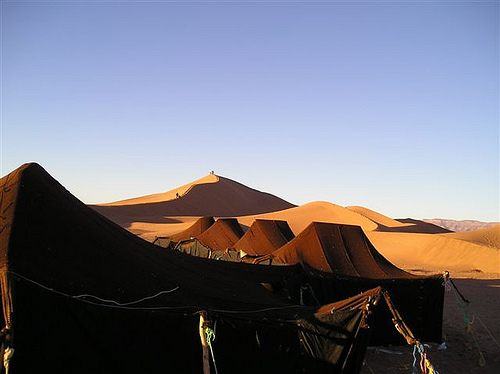
Tinfou Dunes
Tinfou is a tourist attraction – it is a complete but solitary sand dune that has somehow migrated across the hammada and come to rest at its present site. No-one seems to know why it doesn’t disperse, but it has been a boon for the local entrepreneurs. A hotel has been built 300 metres away and a reasonable selection of camels and their owners are available for hire to traipse around the locality.
Not surprisingly, no sooner have we arrived, than a couple of them arrive to tempt us to avail ourselves of their services. With dogged persistence they continue to offer and we continue to decline until a minibus arrives containing more likely looking punters. Our chums decamp to greet them with a thousand welcomes and within a minute, two tourists are perched on top of their camels, and wander off for a spin round Tinfou.
Free from local assistance, we use the time to take a few pictures of the dunes. Simon hides on the shady side of the Terrano. Wearing full biking gear in temperatures of 40 degrees is a sweaty business, and it is barely 10am.
We head back towards Zagora. If we were hard-core off-roaders, we would carry on further south to M’Hamid where the road ends and drive off into the hammada. We, however, are happy to stick to the nursery slopes and turn west along the N12. This road takes us up a huge wadi in the direction of Tata and just past what purports to be an airport, the road turns into a rough graded road bed. It is part of the same road development we followed yesterday, but the surface is a more like piste and bounces us around. When we leave the track to drive on the softer sand, it makes life very difficult for Simon. I am keen to get off the lumpy shards of rock, so we compromise and pick our way through the hard packed sand and gravel of the wadi floor. It is not predictable and we take it in turns to experience extreme angst. We hit a few dead-ends, where we drive into a river-bed, and then through bands of soft sand alternating with great boulder-strewn rock fields. I don’t want to smash the steering or bury the axles and Simon doesn’t want to buckle his wheel or fall off, so we scout around until we find a piste which other vehicles have used. We are trying to reach the edge of the valley where there is more vegetation and shade, but it also seems likely there will be settlements there. We see a large Acacia tree in the near distance and head for that instead.
The tree gives and amazing amount of shade, but in spite of this, nothing can disguise the fact that it is just before noon and we have arrived at our camp rather early. Nothing is said, but no-one seems to have the will to struggle further off-piste and staying on the piste will just take us further up the wadi where there is just more of the same as we have here. I rig up an awning, deploy the camp chairs and brew up. This is the first proper cup of tea we have all had in over a week and even though the milk is powdered the PG Tips has the desired effect and we all feel a little more relaxed.
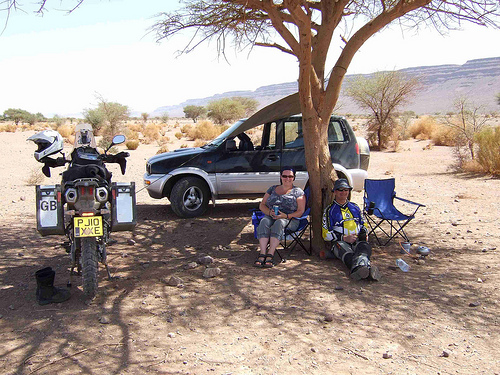
Desert Camp
This doesn’t last long – the wind picks up and begins gusting very hard. At various points across the wadi, dust-devils appear. We are being stoic up to the point that a gust rips an eyelet out of the awning, at which point we decide to take it down and consider taking shelter. Happily no full scale dust-storm materialises and the wind backs off. We settle down again and while away the afternoon reading and chatting.
The wadi is a remarkably busy place. A few old vehicles drive by and some people wander up to see us. They are after cigarettes and water. We brought spare water bottles with us, filled with tap water and are happy to share this. We can’t help with the cigarettes, and they seem genuinely surprised that none of us smoke. Later in the afternoon three boys wander out from the thorn bushes and say hello. They then sit down near us and just watch us. This was supposed to be our ‘wilderness day’ and it is not turning out the way we had planned; we feel more like the local attraction. Our mistake may have been to have given them some boiled sweets. They begin muttering about ‘gateau’ which would suggest they are wildly over-estimating our capacity for luxury items. I would be very happy with a bottle of cold water. Just when we think they will never go, they leave. Being the suspicious type, I wonder whether they have gone to get their friends.
The shadows get longer and I reckon it is safe to pitch the tent. I pick a suitably spot in the lee of some thorn bushes and move the Terrano to create a windbreak as it is still gusting a bit. It isn’t great but it is better than nothing. Simon moves his bike and just as we have put up the tent and are considering cooking up some grub, our little friends re-appear complete with three more friends and a herd of goats.
We are guests in what is clearly their playground, but I do wish they could choose another bit of the desert and leave us alone. We think about bribery again and dole out the last of the boiled sweets in the hope that if they see the bag is empty, they will go home. No such luck. Now they want water and finish off the ‘hospitality’ water after which they use the bottle as an improvised football. The match seems to go on for ever but finally ends in tears. As darkness descends we suggest they really ought to go home, but they don’t take the hint and climb all over the Acacia tree. At one point all six are swinging from the branches and one is at the very top. It is lucky we have moved the car and our kit to our pitch. If one of them falls out of the tree, it won’t be on my car.
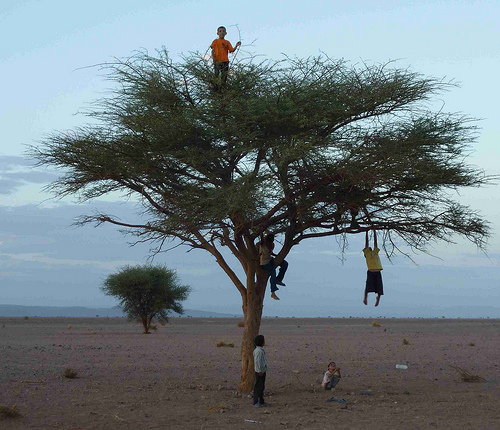
Moroccan kids in an Acacia tree
Amazingly, none of them has an accident and once they come down out of the tree, Louise asks them nicely to leave us alone. Simon underscores the request in ‘bad cop’ fashion by chasing one of them a long way into the bushes and after a while the get the message and disappear into the gloom.
I prepare a two-course evening meal in little silver bags. They don’t take much heating as they have been sitting in the sun for hours, but you have to go through the motions. By the time we eat, it is in moonlight, which is possibly the best time to consume boil-in-a-bag meals. We decide that longer spoon handles would be a significant step forward in eating enjoyment. The wine has also suffered in the heat and is still considerably above room temperature. It cools down considerably once it is in the mug, but you need to wait for 15 minutes, and this creates a dilemma.
Sitting in the sun all day is a tiring business and we prepare for bedtime under the stars. Simon has opted not to put up his tent. He has rolled out his sleeping bag and roll-mat next to his bike for his night under the stars. Louise and I climb into the tent, but in spite of a relatively cool breeze, it is a hot night and hard to get to sleep. A little while later, I wake up to the sound of the wind howling and the tent flapping. I tie back the flaps and check all is OK with Simon, but he is snoring loudly and oblivious to it all. Eventually I get back to sleep.

